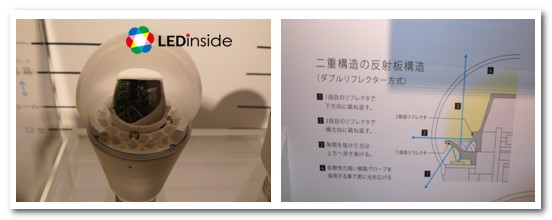Report on Lighting Fair 2011 – LED Light Bulbs
After the announcement of American Energy Star’s LED light bulb criteria, more and more LED light bulbs manufacturers shift their focus from luminous efficacy to luminous quality, with increasing emphasis placed on beam angle of LED light bulbs.
At this year’s Lighting Fair 2011, held at Tokyo Big Sight International Exhibition Center and commencing on March 8 and ending on March 11, LED manufacturers exhibited LED light bulbs with wider beam angles, which indicated that besides luminous efficacy and brightness, manufacturers started to put the accent on beam angel. As a result, the luminous quality of LED light bulbs has become closer to that of incandescent light bulbs, making LED lights a more appealing replacement for traditional consumers.
Panasonic exhibited a new LED light bulb with a wider beam angle and a shape similar to an incandescent light bulb. It announced a regular LED light bulb with a 300 degree beam angle in January, 2011, which could fit in an E26 socket and was to be launched on March 18, 2011. In addition to the three-dimensional arrangement of LED chip, a reflector was installed to the new LED light bulb, which widened the beam angle but decreased the luminous efficacy to 70lm/W, lower than that of previous products. It shows that a sacrifice of luminous efficacy is inevitable in order to widen the beam angle.

Aside from Panasonic, Toshiba also announced a new LED light bulb with a 270 degree beam angle and another one with 1100lm brightness. Based on the introduction, the former’s chip arrangement remained two dimensional as the old LED light bulbs, but the hemispherical shade it used diffused the light, which widened the beam angle. Moreover, Toshiba exhibited ClearType and dimmable LED mini krypton bulb (E17 socket), an addition to product lineup.


Hitachi is no exception regarding this increasing focus on the beam angle. Unlike Panasonic using a reflector, Hitachi placed a lens under the LED light source to widen the beam angle of the LED light bulb.

In terms of wide beam angle LED light bulbs, Germany’s Osram cooperated with Japan’s Mitsubishi and launch a series of LED lighting products. However, there was no significant breakthrough concerning beam angle technology; the new products still adopted the traditional approach: soldering the LED lights to cylinder, which will not be much of a help to increasing overall luminous flux and is more suitable for decorative lighting usage.

















